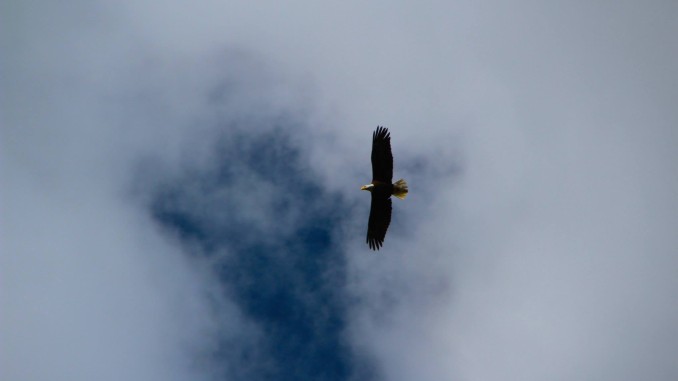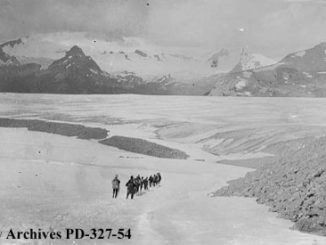
Alberta is home to two species of eagle, the Bald and the Golden. Twice a year these magnificent birds use a narrow strip on the eastern slope of the Rocky Mountains as a highway. In the spring they migrate north to Alaska and the Yukon so they can breed and give birth during the summer. In the fall they reverse course and fly south to spend the winter in warmer locales. For some, this means travelling as far away as the southern United States and Mexico. They can travel hundreds of kilometres each day, making use of the wind and geo-thermal lifts to rise and glide over these considerable distances. Sometimes, when the conditions are perfect, they’ll only need to flap their wings a couple of times over the course of an entire day!
Although the eagle behaviour described above is now well-accepted by the scientific community, this wasn’t always the case. In fact before 1992 it was believed that only a small percentage of the eagle population migrated out of the province, but nobody knew where or why until Peter Sherrington and Des Allen made an enormous discovery. While conducting a routine bird survey in the Mt. Lorette area of Kananaskis the duo observed over 100 Golden Eagles flying northwest across the valley. They speculated that the number of eagles all flying in the same direction couldn’t have been a coincidence and returned to the site a few days later to try and learn more. This was to become the first unofficial observation of eagle migration; a study that’s continued for 23 consecutive years at the Mt. Lorette observation site.

Today a team of volunteers from the Rocky Mountain Eagle Research Foundation (RMERF), working from sunrise to sunset, are responsible for the bi-annual count of raptors in Alberta. They have three different observation sites where the counts take place each spring and fall; the previously mentioned Mt. Lorette, the Frank Slide Interpretive Centre, and Piitaistakis (South Livingstone Ridge), both of which are located in the Crowsnest Pass area of the province.

Last week my co-teacher and I took our students to the Mt. Lorette observation site to learn more about the eagle migration and to assist in the day’s count. We were greeted by Cliff Hansen, the Observer Coordinator and active member of the RMERF, who briefed us on the equipment, the landmarks, and the process for spotting and recording any and all raptor sightings. Our Principal Observer for the day was Joel Duncan, a 10-year veteran of the RMERF and the man who would be identifying and recording the different birds we saw. After our introduction it was time to get to work. Our jobs were to be sky sweepers and inform Joel of any birds we observed. Armed with binoculars we scanned the skies of the surrounding mountain peaks and ridges. Almost immediately we were rewarded with our first Golden Eagle sighting just off the summit of nearby Mt. Lorette. From there the floodgates opened and we were spotting raptors on a regular basis, despite Cliff’s initial warning about the less than ideal wind conditions.


We only spent about three hours at the observation site, but it gave us great insight into all the work that these citizen scientists undertake. The days are long, the weather can be inclement, and breaks can be few and far between, but their love of birds and the mission of the RMERF keeps them coming back day after day, year after year.

Joel spent 10.5 hours at the observation site that day and counted 256 Golden Eagles, 5 Bald Eagles, 6 Red-Tailed Hawks, 6 Rough-Legged Hawks, 2 Cooper’s Hawks, 2 Sharp-Shinned Hawks, 2 Northern Goshawks, and 1 Northern Harrier. The day also marked the highest total of Golden Eagles so far this fall. We only contributed a small percentage to the day’s final count, but we were more than happy just being part of the entire experience.

I would like to take this time to thank Cliff, Joel, and the Rocky Mountain Eagle Research Foundation for allowing us to assist in the raptor observation. All of us learned a great deal about Alberta’s various birds or prey and now have an even greater understanding of all the work that happens behind the scenes while studying wildlife. If you’d like to learn more about the work they do or if you’d like to volunteer your time to assist in the semi-annual count, please visit their website. For additional information about Alberta’s eagles or to learn more about the school program, feel free to stop by our blog.




